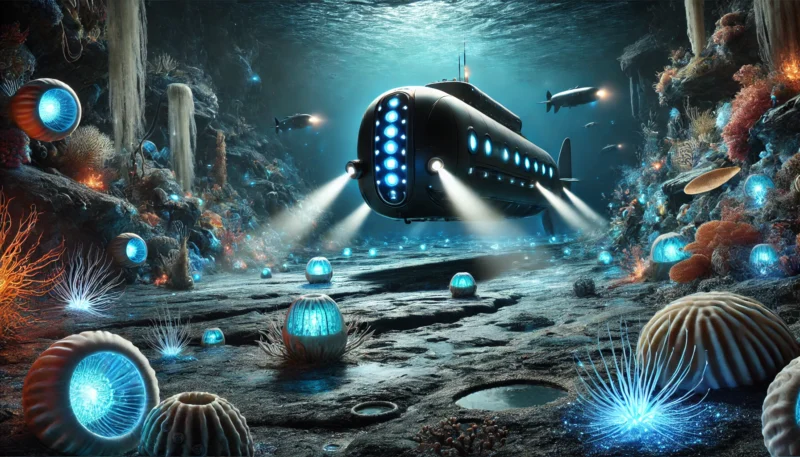
Have you ever wondered what secrets the darkest corners of the ocean might hold—strange creatures flaunting neon patterns, mesmerizing geological formations, or perhaps even precious minerals ready to be harvested for cutting-edge technologies? Over the past few decades, deep-sea exploration has fascinated both scientists and daydreamers, yet most of our underwater world remains uncharted. Now, in 2025, the race to uncover these hidden treasures has taken a futuristic turn with autonomous submarines leading the way.
From heavily funded government programs to private ventures that attract adventurous celebrities, the impetus to probe the depths is a multifaceted effort. The technology behind these advanced submersibles has matured astonishingly fast, enabling them to operate miles under the surface, in pitch-black conditions, all without direct human control. But as with every major leap in exploration, political debates, ethical dilemmas, and economic possibilities swirl around the conversation—sometimes in a manner that is just as murky as the oceans themselves.
Glimpsing the Abyss: Why Deep-Sea Exploration Matters
Some folks insist on climbing mountains, others trek across deserts, but the deepest frontier on Earth is undeniably the ocean floor. According to the United States Geological Survey (USGS), over 80 percent of our oceans remain unmapped, unobserved, and unexplored. This statistic alone ignites the imagination. You might be picturing bioluminescent jellies swirling in undersea canyons, or ghostly fish gliding through ancient shipwrecks. However, the draw goes beyond mere curiosity.
- New Species: Each expedition routinely unearths previously unknown organisms. Many of these discoveries have potential applications in medicine, ranging from antiviral compounds to new forms of antibiotics.
- Resources and Minerals: The deep-sea floor harbors a wealth of rare earth elements, essential for advanced electronics, renewable energy systems, and cutting-edge research.
- Climate Insights: Marine ecosystems act as crucial carbon sinks. Detailed mapping and monitoring provide an understanding of how these systems influence global climate patterns.
But come on, do we truly need fancy robots to do the job? Actually, yes—and here’s why. The extreme conditions—zero sunlight, immense water pressure, and severe cold—make human exploration fraught with challenges. Autonomous submarines fill this gap elegantly, using artificial intelligence and specialized sensor arrays to navigate safely without direct oversight from a piloting crew.
The Rise of Autonomous Submarines
Picture a sleek, torpedo-shaped craft diving thousands of feet, guided by advanced algorithms that adapt to swirling currents and shifting undersea landscapes in real-time. These futuristic subs, sometimes smaller than a sports car, are redefining deep-sea exploration. A few decades ago, we relied heavily on cumbersome manned submersibles tethered to ships. Today, NOAA and various research labs worldwide are pushing the boundaries with vehicles that can self-manage entire expeditions for days—or even weeks—at a stretch.
To break it down:
- Advanced Sensors: High-resolution sonar, chemical detectors, and high-definition video capture help these subs glean an astonishing level of detail from the ocean floor.
- AI Navigation: Machine learning algorithms interpret sonar maps on-the-fly, adjusting routes to avoid terrain hazards while seeking out significant geological or biological markers.
- Communication Systems: Via acoustic modems or satellite relays when surfacing, these submarines transmit data back to scientists or government agencies, often in near real-time.
Critics occasionally raise eyebrows. Are we risking a runaway scenario where we lose control of a sub 10,000 feet below the surface? Thus far, rigorous protocols and fail-safe mechanisms have been instituted to prevent any robotic mutiny in the deep. But as technology becomes more autonomous, these concerns linger, fueling intriguing political discourse and policy-making at higher levels of government.
Government Notes and Policy Directions
In 2025, many governments worldwide are actively crafting marine policies. Environmental stewardship and resource management often top the list of priorities. For instance, the European Union has been drafting new regulations around undersea mineral extraction. They hope to enforce stringent environmental impact assessments before any large-scale mining operation gets a go-ahead.
Meanwhile, agencies in the United States, including NOAA and the Office of Ocean Exploration and Research, collaborate with the U.S. Navy to push forward research in autonomous submarines and their strategic capabilities. The U.S. Congress has occasionally debated the ethics of deep-sea resource extraction—some members champion it as a promising route to bolster domestic high-tech manufacturing, while others worry about the fragile ecosystem that might be disrupted by large-scale exploitation. The friction is real. Yet, the synergy between these agencies fosters technological breakthroughs, all in pursuit of mapping the ocean’s floor more comprehensively and responsibly.
In Asia, government-affiliated institutes in Japan, China, and South Korea invest heavily in next-gen deep-sea vessels. The political angle is not solely about resource extraction but also a race for global prestige: who can map the ocean’s sub-surface features fastest, and who can claim patents for submersible AI technology. In short, deep-sea exploration has become an arena of both collaboration and competition.
Political News and Debates Around Deep-Sea Ventures
Politics can be messy on a good day, and the conversation surrounding deep-sea exploration is no exception. Some claim these missions are vital for national security—spying on undersea cables and ensuring maritime dominance. Others argue that focusing on the deep ocean is a distraction from pressing terrestrial matters like climate change, education, or healthcare.
A recently leaked memo from a major governmental body hinted at an interest in employing autonomous submarines for surveillance tasks beyond pure research. This set off a firestorm of speculation: Are we drifting toward an arms race under the sea? Politicians assure the public that resource mapping and biodiversity surveys remain the primary motives, but given the track record of how technology can be repurposed, the debate rages on.
Despite the controversy, many politicians from across the spectrum acknowledge the significance of deep-sea data for climate modeling. Tectonic activity, methane seeps, and submarine volcanoes all play a role in Earth’s geological processes. Understanding these phenomena, ironically, helps us better predict certain climate shifts. That’s where bipartisan support often emerges—using autonomous submarines as a tool to gather vital data that can influence environmental legislation and global climate treaties.
Inside the Research Labs and Hectic Scientific Circles
Peek into any marine research lab: you might find an old fish tank bubbling in a corner, half-dismantled sonar equipment on a bench, and a group of enthusiastic scientists geeking out over the latest submersible prototype. Places like the Woods Hole Oceanographic Institution in the U.S., or institutes in Europe highlighted by the International Hydrographic Review (IHO), are hotbeds of discovery. Researchers spend months—if not years—on prototypes before launching them on carefully planned missions to detect hydrothermal vents, observe deep-sea fauna, and map ocean trenches.
A groundbreaking study published in a peer-reviewed journal (see PMC8571506) showcased how autonomous submarines could track and film elusive deep-water sharks. The scientists rigged the subs with special low-light cameras, collecting mesmerizing footage of rarely seen predators. They also leveraged environmental DNA (eDNA) sampling capabilities on these robots to identify the microorganisms present in the water. This multipronged approach led to a deeper understanding of how deep-sea sharks influence the marine food web.
Another lab project out of Norway, in partnership with private industry, is focusing on real-time 3D mapping of methane plumes rising from the seafloor. Scientists believe these naturally occurring plumes may have global climate implications. By using advanced submersibles that can stay submerged for extended periods, they’ve generated layered data sets that detail the rate and volume of methane release—and yes, it’s complicated, since ocean currents swirl unpredictably. If you’re a data nerd, it’s a mesmerizing puzzle, albeit with an occasional glitch when onboard AI systems misinterpret a large school of fish as a rock formation.
Celebrity Voices and Enthusiasm
Once upon a time, only famous explorers like Jacques Cousteau snagged the spotlight for oceanic adventures. Now, however, mainstream celebrities are joining the chorus, raising awareness for deep-sea exploration. Singer and global ambassador Pharrell Williams recently tweeted that the oceans are Earth’s “final musical note,” hinting at new philanthropic efforts to fund submersible-based coral reef surveys. Meanwhile, actor Leonardo DiCaprio, known for his environmental activism, has reportedly sponsored an expedition to study plastic pollution in the deep ocean. Both stars emphasize the synergy between preserving marine life and developing advanced ocean-tech, bridging Hollywood glam with marine conservancy.
Skeptics roll their eyes at celebrity endorsements, pointing out the mismatch between star-studded galas and actual undersea fieldwork. But these endorsements undeniably shift public discourse, funneling resources and attention toward labs and institutions that might otherwise scramble for funding. And if a tweet from a big-name celebrity sparks a wave of donations or policy shifts, can we really complain?
Perspectives of the Older Generation
When technology gallops forward at breakneck speed, older adults often voice their concerns—mixed with genuine wonder. The notion of robotic submarines scouring the seafloor can feel like a concept plucked out of a sci-fi movie. At community town halls, elders sometimes ask if these fancy subs might inadvertently scoop up helpless sea creatures or destructively scrape corals. Their lifetime experience fosters caution: “We’ve messed up enough on land. Let’s not repeat the same mistakes underwater.”
There’s also a sense of nostalgia: older folks recall a time when the ocean represented mystery and boundless imagination—Moby-Dick, Jules Verne’s Twenty Thousand Leagues Under the Sea, old black-and-white documentaries showing divers braving the unknown. They get excited hearing that new species are discovered on almost every dive. Yet, they also wonder if the ocean can remain a place of wonder once it’s extensively charted and exploited. A real tension there, right?
However, many older citizens also highlight a positive angle: our capacity for stewardship. They encourage younger scientists not just to gather resources but also to protect marine habitats for future generations. If we can harness the power of autonomous submarines responsibly, they say, maybe we’ll avoid the industrialization fiascos that scarred Earth’s land.
The Youth Perspective: A Wave of Optimism
The younger generation is downright pumped about these underwater drones. They see a future of eco-friendly exploration, where sophisticated subs glide quietly through ocean trenches, beaming back mesmerizing footage, and help drive global solutions for environmental crises. For them, the mere concept of mapping uncharted territory is enthralling—like exploring outer space but right here on our own planet.
In many universities, oceanography clubs have soared in popularity. Students eagerly attend seminars on submarine engineering, marine biology, or even deep-sea geology. Ambitious high schoolers design small, homemade robots to replicate the rudiments of autonomous submarines—though typically for local lake explorations, not quite the Marianas Trench (just yet!). Some of these clubs partner with philanthropic organizations to sponsor small-scale robotic projects that foster environmental awareness.
They also clamor for strong environmental protections. Youth activists pressure governments to ensure that any deep-sea resource extraction is done sustainably, or in some cases, not at all. They see deep-sea exploration as a chance to rewrite the narrative of exploitation and greed that historically marred gold rushes and oil booms. Could we, for once, learn from mistakes on land? The young optimists fervently hope so.
Global Business, Earnings, and Revenue Potential
Where science leads, commerce follows. The potential for profit in the abyss is significant:
- Mineral Extraction: Precious metals like manganese, cobalt, and nickel occur in seafloor deposits. Tech giants need these elements for electric car batteries, solar panels, and countless modern gadgets. Mining them in the deep ocean could be more efficient and less politically fraught than relying on land-based sources—though the environmental cost is still fiercely debated.
- Pharmaceuticals: Strange deep-sea organisms produce unusual enzymes and compounds. Some show promise against antibiotic-resistant bacteria or inflammatory diseases. Biotech companies see big dollar signs in these discoveries.
- Infrastructure and Telecom: Mapping and surveying the seafloor helps with laying fiber-optic cables for better global connectivity. Corporate consortia invest heavily in submarine technologies to reduce disruptions and improve data flow.
According to certain economic projections derived from an analysis in ScienceDirect, the global deep-sea mining market could be worth billions by the early 2030s. Add the revenue from biotech patents, and we’re looking at a genuine economic boom. Critics, however, worry that unregulated business expansions might cause irreparable harm to marine environments. This tension underscores the need for balanced, well-enforced international regulations.
The Social Tug-of-War: Conservation vs. Exploitation
The ocean is sometimes called “humanity’s collective heritage.” Still, who gets to decide what happens in the watery commons? Private companies want resources; governments seek strategic advantages; environmentalists demand preservation; indigenous communities highlight cultural ties to marine territories. The chorus of voices can be downright cacophonous.
Autonomous submarines amplify the conversation. They make deep-sea exploration more feasible and faster than ever before. This accelerated pace spawns fears about insufficient oversight. Some propose an international council to regulate underwater exploration. Others warn that creating more bureaucracy could stifle scientific innovation. The big question: can we strike a delicate balance between responsible resource use and genuine ecological protection?
If we do, it might look something like this:
- Robust Environmental Impact Assessments before each expedition.
- Transparent Data Sharing so that scientists worldwide can analyze findings collectively.
- Equitable Profit-Sharing models where local communities benefit from resource extraction.
Easier said than done. But the stakes are high—both economically and ethically.
Quirks, Hiccups, and Gaps in the Autonomous Journey
Though these craft have soared to new heights (or rather, sank to new depths), the technology isn’t immune to mishaps:
- Navigational Anomalies: AI misidentifies whales or large fish schools as seafloor ridges. This can lead to course corrections that waste battery life or require manual overrides.
- Pressure-Related Failures: Despite advances in hull materials like titanium alloys and carbon composites, the intense water pressure at extreme depths can compromise sensors or cause microfractures.
- Communication Delays: Real-time control is nearly impossible. At great depths, it can take a while for signals to bounce back to research vessels or satellites, forcing subs to operate mostly on autopilot.
Occasionally, projects run out of money or political will. An ambitious multi-year mapping program might suddenly be defunded due to shifting governmental priorities. Labs scramble to find new sponsors or pivot to smaller-scale missions. This can hamper momentum. Despite these glitches, the unstoppable march of progress continues, fueling both scientific excitement and corporate ambitions.
Ethical Edge Cases and Future Prospects
One major ethical dilemma is whether to tap deep-sea resources for critical minerals. On one hand, proponents claim these resources might ease the global transition away from fossil fuels. On the other, environmentalists argue extracting them from fragile benthic ecosystems could lead to unknown ecological damage. Some scientists insist we must at least map the ocean floor thoroughly before making any exploitation decisions. Others caution that once big money floods in, the cautious approach might be overshadowed by a resource gold rush.
Looking ahead a few decades, it’s not inconceivable that we’ll see entire fleets of advanced submersibles patrolling ocean floors, performing tasks ranging from waste cleanup to policing illegal fishing. The potential is staggering: real-time aquaculture monitoring, pipeline and cable inspection, or maybe even specialized subs that protect coral reefs from invasive species. There are also whispers of one day harnessing undersea geothermal vents for renewable energy. Each possibility begs questions about the line between progress and overreach.
One area of research that’s particularly thrilling is the possibility of “deep-sea cities”—submerged stations or research habitats. While this still feels far-fetched, scientists have toyed with the concept of permanent seafloor modules where humans live for extended periods, studying the environment in situ. Autonomous submarines would handle logistics like ferrying supplies or hauling waste to the surface. Could we see a new frontier of “blue colonization”? Or is that yet another pipe dream?
Uneven Tone Alert: A Personal Digression
When I was a kid, I remember being absolutely hypnotized by a nature documentary. It showed a submersible shining its lights on a cluster of fluorescent corals. It was so jaw-droppingly beautiful that I refused to look away. Now, seeing these leaps in deep-sea exploration technology, my inner child leaps with joy. But a hint of anxiety also kicks in: Are we about to exploit these hidden wonders to the point of no return? The tension is real, and I don’t have a neat solution wrapped in a bow.
Yet, I suspect that same wonder—alive in kids, elders, celebrities, and scientists alike—might drive us to be responsible caretakers of the ocean. After all, the deep sea has existed long before we even realized it was down there, and it might outlast us if we fail to treat it with respect. Just a random thought that might or might not comfort you.
Action Steps and Staying Informed
So, how do we, as individuals, keep track of what’s unfolding beneath the waves?
- Follow Research Institutions: Subscribe to newsletters from places like NOAA, USGS, or your local marine research labs.
- Engage Politically: Write to representatives or senators, asking them to support responsible ocean policies and fund scientific exploration.
- Support Conservation Groups: Nonprofit organizations often run programs that protect marine biodiversity. If you can, donate or volunteer.
- Champion Sustainable Tech: Advocate for resource extraction methods—if any—that minimize harm, and push for strong environmental review processes.
Moreover, share these conversations with others. The more mainstream knowledge about autonomous submarines and deep-sea exploration, the better our collective chance of making informed decisions.
Frequently Asked Questions (FAQs)
Q1: Are autonomous submarines really safe to deploy in the deep sea?
Yes, reputable research institutions and private companies incorporate multiple safety measures and fail-safes. The submarines are designed to handle extreme pressures, and if they run into a navigation issue, they typically return to shallower waters.
Q2: How do these subs communicate without direct human control?
They often rely on acoustic signals undersea and switch to satellite relays once they surface. Real-time communication is limited by water’s density, so a certain level of autonomy is required for immediate decision-making.
Q3: Could deep-sea mining harm marine ecosystems?
Potentially, yes. Disturbing the ocean floor can displace or destroy habitats. That’s why environmental impact assessments and international regulations are hotly debated. Conservation-minded scientists urge caution to prevent irreversible damage.
Q4: What about the economic benefits of undersea mineral extraction?
They can be huge. Rare earth elements are crucial for high-tech sectors, including renewable energy solutions. Still, balancing the economic gains with ecological sustainability remains a challenge.
Q5: How can everyday people get involved?
Stay informed, support conservation groups, and advocate for responsible policies. You might also participate in citizen science projects that track marine life data. Spreading awareness online helps, too.
Wrapping Up the Underwater Odyssey
Despite the complexities—and occasional controversies—deep-sea exploration with autonomous submarines stands as one of the most exhilarating frontiers in modern science. Governments see it as a strategic edge, research labs treat it as a goldmine for new knowledge, businesses eye potential profits, celebrities champion awareness campaigns, and everyday folks either watch in awe or voice ethical concerns. With each fresh mission into the silent depths, we’re reminded of just how little we truly understand about our own planet.
Next time someone mentions the final frontier, it might not be space. It could be the uncharted ocean floors right here at home, brimming with life forms that defy our expectations, minerals that could power the next generation of devices, and stories waiting to be told—if we handle it all with care.
Ready to Dive Deeper?
- Stay Connected: Sign up for our newsletter and receive exclusive interviews with marine scientists and environmental policymakers.
- Support Sustainability: Consider volunteering at local marine conservation programs or spreading the word about ocean protection efforts in your community.





